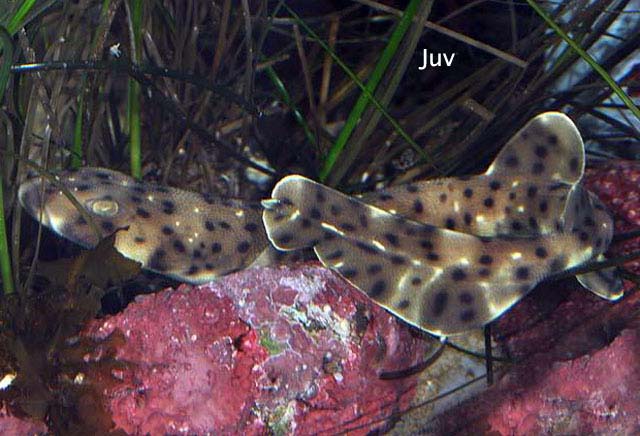swell shark on:
[Wikipedia]
[Google]
[Amazon]
The swell shark (''Cephaloscyllium ventriosum'') is a catshark in the
Cephaloscyllium ventriosum head.jpg, Head
Cephaloscyllium ventriosum jaws.jpg, Jaws
Cephaloscyllium ventriosum lower teeth.jpg, Lower teeth
Cephaloscyllium ventriosum upper teeth 2.jpg, Upper teeth
 The swell shark is
The swell shark is
 Swell sharks hunt at night for
Swell sharks hunt at night for

 Swell shark
Swell shark
family
Family (from ) is a Social group, group of people related either by consanguinity (by recognized birth) or Affinity (law), affinity (by marriage or other relationship). It forms the basis for social order. Ideally, families offer predictabili ...
Scyliorhinidae
Scyliorhinidae is a Family (biology), family of sharks, one of a few families whose members share the common name catsharks, belonging to the Order (biology), order Carcharhiniformes, the ground sharks. Although they are generally known as cats ...
. It is found in the tropical
The tropics are the regions of Earth surrounding the equator, where the sun may shine directly overhead. This contrasts with the temperate or polar regions of Earth, where the Sun can never be directly overhead. This is because of Earth's ax ...
and subtropical
The subtropical zones or subtropics are geographical zone, geographical and Köppen climate classification, climate zones immediately to the Northern Hemisphere, north and Southern Hemisphere, south of the tropics. Geographically part of the Ge ...
eastern Pacific Ocean
The Pacific Ocean is the largest and deepest of Earth's five Borders of the oceans, oceanic divisions. It extends from the Arctic Ocean in the north to the Southern Ocean, or, depending on the definition, to Antarctica in the south, and is ...
from between central California to southern Mexico, with an additional population off the coast of Chile. They are known to have brown and white spots along with broad heads. As a defense, the swell shark is able to expand to approximately double its regular size by swallowing water. They depend on electrical signals to find prey, camouflaging in rocky crevices.
Taxonomy
When discovered in 1880, the swell shark was first described as ''Scyllium ventriosum'', but was later changed to ''Cephaloscyllium ventriosum''. The genus name comes from the Greek word ''kephale'', which means "head", and ''skylla'', which means a certain kind of shark. The species name comes from the Latin word , which means "large-bellied". The species name refers to its ability to enlarge itself by taking in water.Distribution and habitat
The swell shark is found in the eastern Pacific Ocean, from the centralCalifornia
California () is a U.S. state, state in the Western United States that lies on the West Coast of the United States, Pacific Coast. It borders Oregon to the north, Nevada and Arizona to the east, and shares Mexico–United States border, an ...
coast to southern Mexico
Mexico, officially the United Mexican States, is a country in North America. It is the northernmost country in Latin America, and borders the United States to the north, and Guatemala and Belize to the southeast; while having maritime boundar ...
. There is an additional population off the coast of Chile. It can be found between the depths of , but is most common between .
Swell sharks are often found over algae-covered rocky bottoms where it hides in crevices during the day.
Description
Swell sharks are typically around in length, with a maximum length of . They have flat, broad heads with large gold eyes that have nictitating eyelids. Swell sharks have a yellow-brown coloration, with brown and white spots. The spots cover their underside, but are not present on their fins. Usually the younger sharks are lighter in color than the adults. Thegills
A gill () is a respiratory organ that many aquatic organisms use to extract dissolved oxygen from water and to excrete carbon dioxide. The gills of some species, such as hermit crabs, have adapted to allow respiration on land provided they are ...
of a swell shark are usually very small and tight.
Every swell shark has around 55–60 teeth. Teeth typically have three smooth cusps, but can have as many as five cusps. The middle cusp is the longest. Ecology
Swell sharks arenocturnal
Nocturnality is a ethology, behavior in some non-human animals characterized by being active during the night and sleeping during the day. The common adjective is "nocturnal", versus diurnality, diurnal meaning the opposite.
Nocturnal creatur ...
and sleep in rock crevices during the day, where their appearance allows them to be camouflaged. They are very sociable and are commonly seen sleeping next to or on top of other sharks.
Reproduction
 The swell shark is
The swell shark is oviparous
Oviparous animals are animals that reproduce by depositing fertilized zygotes outside the body (i.e., by laying or spawning) in metabolically independent incubation organs known as eggs, which nurture the embryo into moving offsprings kno ...
, laying two green or amber flattened eggs at a time. Fertilization occurs internally. The egg cases become attached to kelp or the reef with tendril
In botany, a tendril is a specialized Plant stem, stem, leaf or Petiole (botany), petiole with a thread-like shape used by climbing plants for support and attachment, as well as cellular invasion by parasitic plants such as ''Cuscuta''. There ar ...
s. It has been suggested that the length of the tendrils depends on the amount of surf action the region is under. After producing the egg case, no parental care is provided. The egg case which contains the embryo
An embryo ( ) is the initial stage of development for a multicellular organism. In organisms that reproduce sexually, embryonic development is the part of the life cycle that begins just after fertilization of the female egg cell by the male sp ...
is approximately –
by –. The embryos will feed solely on yolk
Among animals which produce eggs, the yolk (; also known as the vitellus) is the nutrient-bearing portion of the egg whose primary function is to supply food for the development of the embryo. Some types of egg contain no yolk, for example bec ...
before they hatch. The gestation time depends on water temperature but is typically between 9–12 months. Pups have a double row of enlarged dermal denticles to help them exit the eggcase. After hatching, the pup is approximately in length and is fully self-sufficient.
Diet
 Swell sharks hunt at night for
Swell sharks hunt at night for bony fish
Osteichthyes ( ; ), also known as osteichthyans or commonly referred to as the bony fish, is a Biodiversity, diverse clade of vertebrate animals that have endoskeletons primarily composed of bone tissue. They can be contrasted with the Chondricht ...
, molluscs
Mollusca is a phylum of protostome, protostomic invertebrate animals, whose members are known as molluscs or mollusks (). Around 76,000 extant taxon, extant species of molluscs are recognized, making it the second-largest animal phylum ...
, and crustaceans
Crustaceans (from Latin meaning: "those with shells" or "crusted ones") are invertebrate animals that constitute one group of Arthropod, arthropods that are traditionally a part of the subphylum Crustacea (), a large, diverse group of mainly aquat ...
. They will eat prey that is dead or alive. They feed either by sucking prey into their mouth or by waiting motionless on the sea floor with their mouth open, waiting to encounter prey. Swell sharks have also been known to look for food in lobster traps.
Predation
Swell sharks feed predominantly in nighttime conditions, using an ambush strategy to attack prey. Sensory modality in swell sharks allow for detection of prey up to 20 cm in small sharks through electric fields emitted by such prey.Defense
When the shark feels threatened, it will bend its body into a U–shape, grab its tail fin with its mouth, and suck in water. Doing so causes the shark to enlarge in diameter and makes it much harder for predators to bite or dislodge. The swell shark is capable of swelling by using water or air, which is stored in the stomach until released. When letting air out, the swell shark makes a dog-like bark. Swell sharks are non-aggressive and are considered harmless to humans.
Biofluorescence
 Swell shark
Swell shark biofluorescence
Biofluorescence is fluorescence exhibited by a living organism: part of the organism absorbs light or other radiation at one wavelength and emits visible light at another, usually longer. The absorbed radiation is often blue or ultraviolet, while t ...
was first reported in 2014. Researchers presented species-specific emission patterns, indicating that biofluorescence potentially functions in intraspecific communication and assists camouflage. The key fluorescent pigments in the swell shark and the chain catshark are a set of brominated kynurenine
-Kynurenine is a metabolite of the amino acid -tryptophan used in the production of niacin.
Kynurenine is synthesized by the enzyme tryptophan dioxygenase, which is made primarily but not exclusively in the liver, and indoleamine 2,3-dioxygena ...
compounds that appear to be synthesized by the kynurenine pathway starting from 6-bromo-tryptophan
Tryptophan (symbol Trp or W)
is an α-amino acid that is used in the biosynthesis of proteins. Tryptophan contains an α-amino group, an α-carboxylic acid group, and a side chain indole, making it a polar molecule with a non-polar aromat ...
. The biochemical origin of 6-bromo-tryptophan in these species is not known.
Conservation status
There are no fishery operations that target swell sharks; however, they are occasionally caught as bycatch in lobster and crab traps, gillnets, and trawls. Swell sharks are not typically consumed by humans due to the poor quality of meat. Swell sharks are common in public aquariums, in part due to their longevity in captivity. TheIUCN
The International Union for Conservation of Nature (IUCN) is an international organization working in the field of nature conservation and sustainable use of natural resources. Founded in 1948, IUCN has become the global authority on the status ...
has assessed the swell shark as "least concern".
References
{{Taxonbar, from=Q2639496 Cephaloscyllium Western American coastal fauna Fish described in 1880